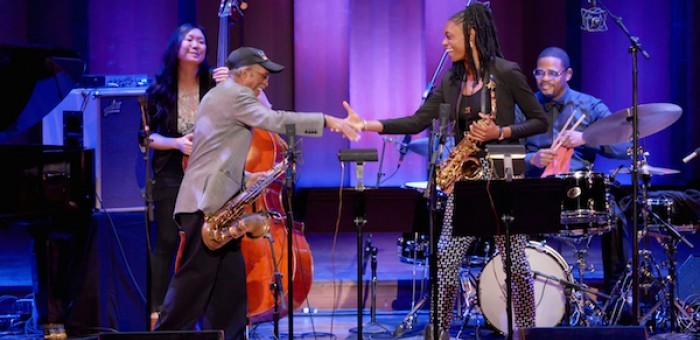Oct 28, 2025 10:47 AM
In Memoriam: Jack DeJohnette, 1942–2025
Jack DeJohnette, a bold and resourceful drummer and NEA Jazz Master who forged a unique vocabulary on the kit over his…

Linda Oh (left, with bass), Jimmy Heath, Lakecia Benjamin and Karriem Riggins perform at the NEA Jazz Masters ceremony in Washington, D.C., on April 4.
(Photo: Shannon Finney/NEA)Vibraphonist Gary Burton, saxophonists Pharoah Sanders and Archie Shepp, and Jazz Foundation of America Executive Director Wendy Oxenhorn were honored as Jazz Masters by the National Endowment of the Arts on April 4 at a star-studded concert streamed live from the Kennedy Center in Washington, D.C.
The swiftly moving program, less than two hours long, marked the 34th year of Jazz Masters tributes and the 50th anniversary of the establishment of the NEA.
After introductory remarks by pianist Jason Moran, the Kennedy Center’s artistic director for jazz, and NEA chairperson Jane Chu, brief video portraits of each of the Masters (with testimonials from artists they’d influenced) intermingled with ensemble performances and remarks by the Masters themselves. Kennedy Center president Deborah F. Rutter also spoke.
To represent Shepp’s music, a rowdy octet of Moran, tenor saxophonist David Murray, alto saxophonist Rudresh Mahanthappa, trumpeter Ambrose Akinmusire, trombonist Roswell Rudd, bassist Linda Oh, drummer Karriem Riggins and conguero Pedrito Martinez blew on Shepp’s multi-themed, politically conscious compositions “Hambone” and “Blues For Brother George Jackson.”
Pianist Chick Corea reprised “Crystal Silence,” a 1974 duet with Burton that commenced their 42-year creative partnership, this time with Stefon Harris on vibes. Referring to the spiritual dimension ascribed to Sanders’ music, pianist Randy Weston offered his own composition “The Healers,” abetted by tenor saxophonist Billy Harper.
To toast Oxenhorn, tenor saxophonist Jimmy Heath led a spirited band through his bluesy “Gingerbread Boy” with alto saxophonist Lakecia Benjamin, pianist Justin Kauflin, Oh and Riggins. There were personal connections here: Kauflin and Benjamin, when suffering from health crises, had both received support from the Jazz Foundation of America, and Heath has been a fervent supporter of the organization.
For the finale, that ensemble backed vocalist Catherine Russell on “I Wish I Knew How It Felt To Be Free,” a gospel-tinged song written by the late Dr. Billy Taylor—who was the first artistic director for jazz at the Kennedy Center, and also a Jazz Foundation founder. The audience clapped along, congregation-style, emphasizing beats two and four.
Corea, Weston and Heath are previously named Jazz Masters, among the 140 musicians who have been so designated by the NEA, and it was inevitable to conjecture about the number of future Jazz Masters onstage.
While all the musicians demonstrated the expected high level of virtuosity and expressivity, it was particularly gratifying to hear Weston, who celebrates his 90th birthday on April 6, and Heath, turning 90 on Oct. 25, both play with undiminished vitality and sheer musicality.
In addition to the prestige, Masters receive a $25,000 honorarium. Shepp was gracious but incisive, urging artists to be activists, too, and insisting that the arts should not only be available to middle class Americans but to everyone. He noted that the arts should be included in public educational programs as a method for “creating hope where there is despair.”
Burton, lauded for his four-mallet technical innovations and pioneering fusion of jazz with elements of rock ’n’ roll, classical and country music, was characteristically modest, and spoke of his pride in the accomplishments of students he’d mentored during his long tenure at Berklee School of Music.
Sanders, who extended saxophone vocabulary into extreme high registers and multi-phonics, has often been described as soft-spoken. In his speech, he alluded to his best known recording, “The Creator Has A Master Plan” and thanked “all the musicians tonight here who got together to play this beautiful music.”
Oxenhorn, who received the NEA’s A.B. Spellman Award for Jazz Advocacy, was described in the NEA’s video portrait as an “angel” for her dedication to musicians in need of not only financial assistance but also work that provides dignity.
She spoke passionately about music as the result and response to pain, the universality of human experience and her faith that “everything is going to be all right.” Asserting that the Jazz Foundation’s mission is to help people who would seldom if ever ask for help themselves, she concluded by thanking her staff and “the people who make the music.”
The Kennedy Center’s Concert Hall was not quite full to capacity, but the audience included many musicians and music activists. This concert was the most publicly accessible of several events surrounding the Jazz Masters investitures, which included a “listening party” at National Public Radio headquarters, a “Tiny Desk Concert” at NPR by Gary Burton and Chick Corea, and a master class for D.C. public school students, held at the Duke Ellington High School for the Arts.

Jack DeJohnette boasted a musical resume that was as long as it was fearsome.
Oct 28, 2025 10:47 AM
Jack DeJohnette, a bold and resourceful drummer and NEA Jazz Master who forged a unique vocabulary on the kit over his…

Goodwin was one of the most acclaimed, successful and influential jazz musicians of his generation.
Dec 9, 2025 12:28 PM
Gordon Goodwin, an award-winning saxophonist, pianist, bandleader, composer and arranger, died Dec. 8 in Los Angeles.…

Flea has returned to his first instrument — the trumpet — and assembled a dream band of jazz musicians to record a new album.
Dec 2, 2025 2:01 AM
After a nearly five-decade career as one of his generation’s defining rock bassists, Flea has returned to his first…

Nov 13, 2025 10:00 AM
For results of DownBeat’s 90th Annual Readers Poll, complete with feature articles from our December 2025 issue,…

To see the complete list of nominations for the 2026 Grammy Awards, go to grammy.com.
Nov 11, 2025 12:35 PM
The nominations for the 2026 Grammy Awards are in, with plenty to smile about for the worlds of jazz, blues and beyond.…








